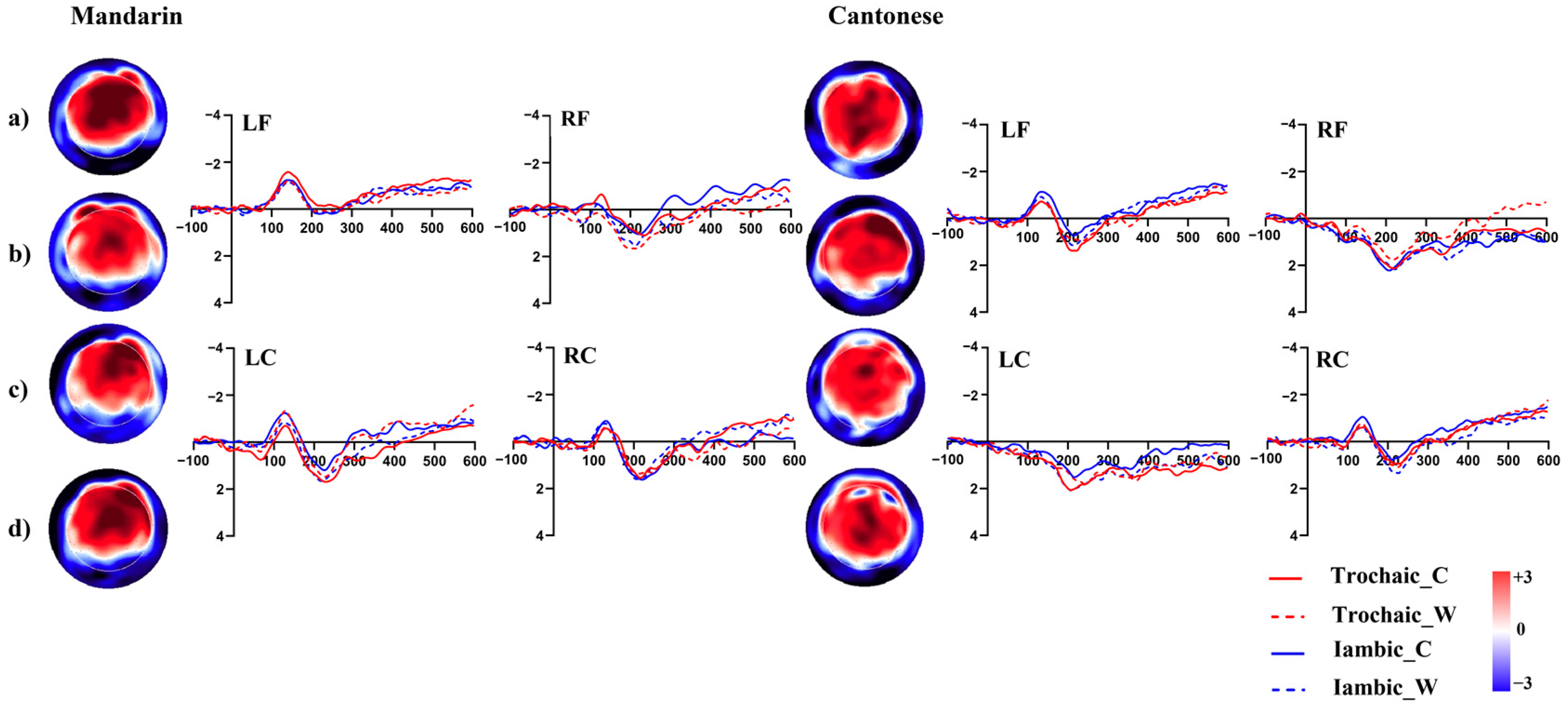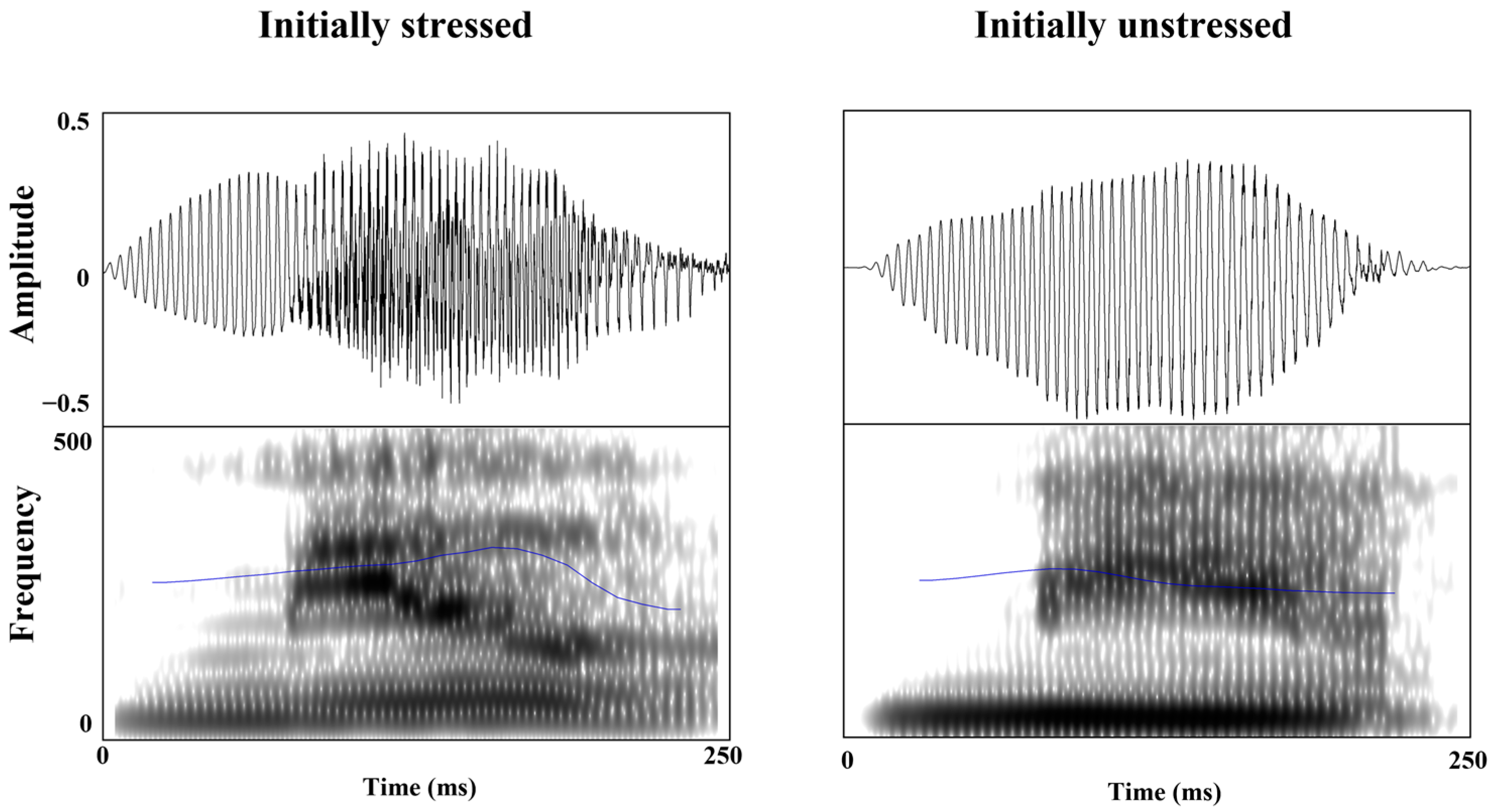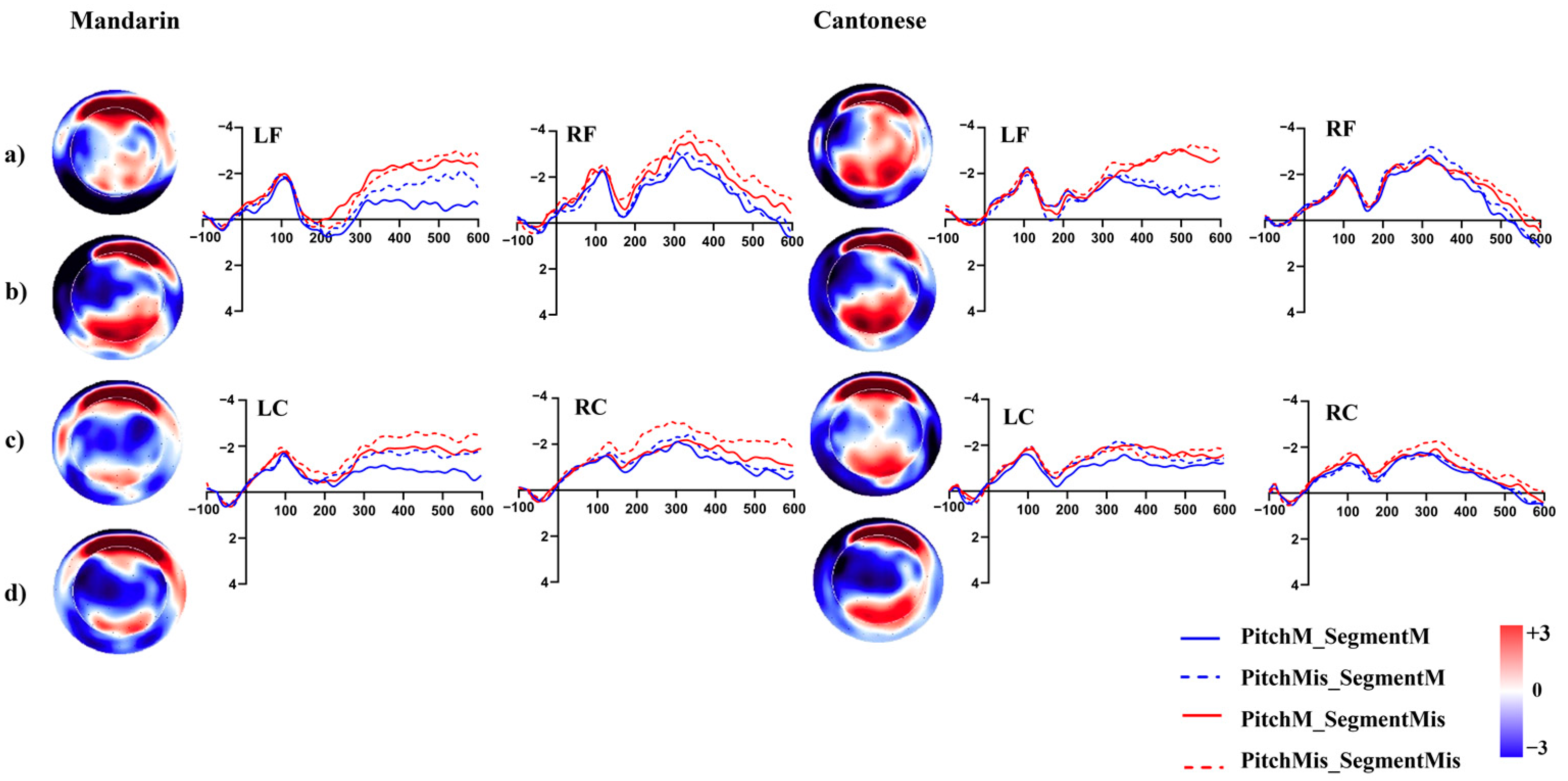Spoken Word Recognition across Language Boundary: ERP Evidence of Prosodic Transfer Driven by Pitch
Abstract
1. Introduction
1.1. Prosodic Transfer in Previous Studies
1.2. The Current Study
2. Experiment 1
2.1. Methods
2.1.1. Participants
2.1.2. Materials
2.1.3. Procedure
2.1.4. EEG Recordings and Analysis
2.2. Results
2.2.1. Behavioural Results
2.2.2. ERP Results
2.3. Discussion
3. Experiment 2
3.1. Method
3.1.1. Participants
3.1.2. Materials
3.1.3. Procedure
3.1.4. EEG Recordings and Analysis
3.2. Results
Behavioural Results
3.3. Discussion
4. General Discussion
5. Conclusions
Author Contributions
Funding
Institutional Review Board Statement
Informed Consent Statement
Data Availability Statement
Conflicts of Interest
References
- Dahan, D.; Magnuson, J.S. Spoken word recognition. In Handbook of Psycholinguistics; Elsevier: Amsterdam, The Netherlands, 2006; pp. 249–283. [Google Scholar]
- McQueen, J.M. Speech perception. In The Handbook of Cognition; SAGE Publications: New York, NY, USA, 2005; pp. 255–275. [Google Scholar]
- Marslen-Wilson, W.D. Functional parallelism in spoken word-recognition. Cognition 1987, 25, 71–102. [Google Scholar] [CrossRef]
- McQueen, J.M. Eight questions about spoken-word recognition. In The Oxford Handbook of Psycholinguistics; Oxford University Press: Oxford, UK, 2007; pp. 37–53. [Google Scholar]
- Norris, D. Shortlist: A connectionist model of continuous speech recognition. Cognition 1994, 52, 189–234. [Google Scholar] [CrossRef]
- Luce, P.A.; Pisoni, D.B. Recognizing spoken words: The neighborhood activation model. Ear Hear. 1998, 19, 1–36. [Google Scholar] [CrossRef]
- McClelland, J.L.; Elman, J.L. The TRACE model of speech perception. Cogn. Psychol. 1986, 18, 1–86. [Google Scholar] [CrossRef]
- Cooper, N.; Cutler, A.; Wales, R. Constraints of lexical stress on lexical access in English: Evidence from native and non-native listeners. Lang. Speech 2002, 45, 207–228. [Google Scholar] [CrossRef]
- Fry, D.B. The dependence of stress judgments on vowel formant structure. In Phonetic Sciences; Karger Publishers: Berlin, Germany, 1965; pp. 306–311. [Google Scholar]
- Cutler, A. Lexical stress. In The Handbook of Speech Perception; Blackwell Publishing: Oxford, UK, 2005; pp. 264–289. [Google Scholar]
- Cutler, A.; Clifton, C. The use of prosodic information in word recognition. In Attention and Performance X: Control of Language Processes; Lawrence Erlbaum: London, UK, 1984; pp. 183–196. [Google Scholar]
- Field, J. Intelligibility and the listener: The role of lexical stress. TESOL Q. 2005, 39, 399–423. [Google Scholar] [CrossRef]
- Lehiste, I.; Lass, N.J. Suprasegmental features of speech. Contemp. Issues Exp. Phon. 1976, 225, 239. [Google Scholar]
- Cutler, A. Forbear is a homophone: Lexical prosody does not constrain lexical access. Lang. Speech 1986, 29, 201–220. [Google Scholar] [CrossRef]
- Soto-Faraco, S.; Sebastián-Gallés, N.; Cutler, A. Segmental and suprasegmental mismatch in lexical access. J. Mem. Lang. 2001, 45, 412–432. [Google Scholar] [CrossRef]
- Cutler, A.; Van Donselaar, W. Voornaam is not (really) a homophone: Lexical prosody and lexical access in Dutch. Lang. Speech 2001, 44, 171–195. [Google Scholar] [CrossRef]
- Bradlow, A.R. A comparative acoustic study of English and Spanish vowels. J. Acoust. Soc. Am. 1995, 97, 1916–1924. [Google Scholar] [CrossRef]
- Zellers, M.; Post, B.; Williams, J. Implicit Learning of Lexical Stress Patterns. In Proceedings of the ICPhS, Hong Kong, China, 17–21 August 2011; pp. 2260–2263. [Google Scholar]
- Dupoux, E.; Sebastián-Gallés, N.; Navarrete, E.; Peperkamp, S. Persistent stress ‘deafness’: The case of French learners of Spanish. Cognition 2008, 106, 682–706. [Google Scholar] [CrossRef]
- Peperkamp, S.; Vendelin, I.; Dupoux, E. Perception of predictable stress: A cross-linguistic investigation. J. Phon. 2010, 38, 422–430. [Google Scholar] [CrossRef]
- Allen, G.D. Linguistic experience modifies lexical stress perception. J. Child Lang. 1983, 10, 535–549. [Google Scholar] [CrossRef]
- Rasier, L.; Hiligsmann, P. Prosodic transfer from L1 to L2. Theoretical and methodological issues. Nouv. Cah. Linguist. Française 2007, 28, 41–66. [Google Scholar]
- Ueyama, M. Prosodic Transfer: An Acoustic Study of L 2 English vs. L 2 Japanese; UCLA: Los Angeles, CA, USA, 2000. [Google Scholar]
- Edwards, J.G.H.; Zampini, M.L. Phonology and Second Language Acquisition; John Benjamins Publishing: Amsterdam, The Netherlands, 2008; Volume 36. [Google Scholar]
- Zhang, J.; McBride-Chang, C. Auditory sensitivity, speech perception, L1 Chinese, and L2 English reading abilities in Hong Kong Chinese children. Dev. Psychol. 2014, 50, 1001. [Google Scholar] [CrossRef]
- Chrabaszcz, A.; Winn, M.; Lin, C.Y.; Idsardi, W.J. Acoustic cues to perception of word stress by English, Mandarin, and Russian speakers. J. Speech Lang. Hear. Res. 2014, 57, 1468–1479. [Google Scholar] [CrossRef]
- Ding, H.; Hoffmann, R.; Hirst, D. Prosodic transfer: A comparison study of f0 patterns in l2 english by chinese speakers. In Proceedings of the Speech Prosody, Boston, MA, USA, 31 May–3 June 2016; pp. 756–760. [Google Scholar]
- Qin, Z.; Chien, Y.-F.; Tremblay, A. Processing of word-level stress by Mandarin-speaking second language learners of English. Appl. Psycholinguist. 2017, 38, 541–570. [Google Scholar] [CrossRef]
- Yu, V.Y.; Andruski, J.E. A cross-language study of perception of lexical stress in English. J. Psycholinguist. Res. 2010, 39, 323–344. [Google Scholar]
- Tong, Y.; Francis, A.L.; Gandour, J.T. Processing dependencies between segmental and suprasegmental features in Mandarin Chinese. Lang. Cogn. Process. 2008, 23, 689–708. [Google Scholar] [CrossRef]
- Davenport, M.; Hannahs, S.J. Introducing Phonetics and Phonology; Routledge: Oxfordshire, UK, 2013. [Google Scholar]
- Llisterri, J. Speaking styles in speech research. In Proceedings of the Workshop on Integrating Speech and Natural Language, New York, NY, USA, 23–26 February 1992. [Google Scholar]
- Lass, N. Contemporary Issues in Experimental Phonetics; Elsevier: Amsterdam, The Netherlands, 2012. [Google Scholar]
- Tong, Y.; McBride, C.; Zhang, J.; Chung, K.K.; Lee, C.-Y.; Shuai, L.; Tong, X. Neural correlates of acoustic cues of English lexical stress in Cantonese-speaking children. Brain Lang. 2014, 138, 61–70. [Google Scholar] [CrossRef] [PubMed]
- Zhang, Y.; Nissen, S.L.; Francis, A.L. Acoustic characteristics of English lexical stress produced by native Mandarin speakers. J. Acoust. Soc. Am. 2008, 123, 4498–4513. [Google Scholar] [CrossRef] [PubMed]
- Wang, Q. L2 stress perception: The reliance on different acoustic cues. In Proceedings of the Speech Prosody, Campinas, Brazil, 6–9 May 2008; pp. 135–138. [Google Scholar]
- Zhang, J.; Meng, Y.; Fan, X.; Ortega-Llebaria, M.; Ieong, S.L. Stress typicality effect in Chinese advanced and intermediate ESL learners. Educ. Psychol. 2018, 38, 617–632. [Google Scholar] [CrossRef]
- Zhang, Y.; Francis, A. The weighting of vowel quality in native and non-native listeners’ perception of English lexical stress. J. Phon. 2010, 38, 260–271. [Google Scholar] [CrossRef]
- Tsang, Y.-K.; Jia, S.; Huang, J.; Chen, H.-C. ERP correlates of pre-attentive processing of Cantonese lexical tones: The effects of pitch contour and pitch height. Neurosci. Lett. 2011, 487, 268–272. [Google Scholar] [CrossRef]
- Friedrich, C.K.; Kotz, S.A.; Friederici, A.D.; Alter, K. Pitch modulates lexical identification in spoken word recognition: ERP and behavioral evidence. Cogn. Brain Res. 2004, 20, 300–308. [Google Scholar] [CrossRef]
- Gandour, J. Tone perception in Far Eastern languages. J. Phon. 1983, 11, 149–175. [Google Scholar] [CrossRef]
- Liu, S.; Samuel, A.G. Perception of Mandarin lexical tones when F0 information is neutralized. Lang. Speech 2004, 47, 109–138. [Google Scholar] [CrossRef]
- Khouw, E.; Ciocca, V. Perceptual correlates of Cantonese tones. J. Phon. 2007, 35, 104–117. [Google Scholar] [CrossRef]
- Lee, Y.S.; Vakoch, D.A.; Wurm, L.H. Tone perception in Cantonese and Mandarin: A cross-linguistic comparison. J. Psycholinguist. Res. 1996, 25, 527–542. [Google Scholar] [CrossRef]
- Friedrich, C.K.; Alter, K.; Kotz, S.A. An electrophysiological response to different pitch contours in words. NeuroReport 2001, 12, 3189–3191. [Google Scholar] [CrossRef]
- Lemhöfer, K.; Broersma, M. Introducing LexTALE: A quick and valid lexical test for advanced learners of English. Behav. Res. Methods 2012, 44, 325–343. [Google Scholar] [CrossRef]
- Balota, D.; Yap, M.; Cortese, M.; Hutchison, K.; Kessler, B.; Loftis, B.; Neely, J.; Nelson, D.; Simpson, G.; Treiman, R. The English lexicon project. Behav. Res. Methods 2007, 39, 445–459. [Google Scholar] [CrossRef]
- Brysbaert, M.; New, B. Moving beyond Kučera and Francis: A critical evaluation of current word frequency norms and the introduction of a new and improved word frequency measure for American English. Behav. Res. Methods 2009, 41, 977–990. [Google Scholar] [CrossRef]
- Friedrich, C.K. Prosody and spoken word recognition: Behavioral and ERP correlates. Ph.D. Thesis, Max Planck Institute of Cognitive Neuroscience, Leipzig, Germany, 2003. [Google Scholar]
- Marie, C.; Magne, C.; Besson, M. Musicians and the metric structure of words. J. Cogn. Neurosci. 2011, 23, 294–305. [Google Scholar] [CrossRef]
- Tremblay, K.; Kraus, N.; McGee, T.; Ponton, C.; Otis, B. Central auditory plasticity: Changes in the N1-P2 complex after speech-sound training. Ear Hear. 2001, 22, 79–90. [Google Scholar] [CrossRef]
- Dumay, N.; Benraiss, A.; Barriol, B.; Colin, C.; Radeau, M.; Besson, M. Behavioral and electrophysiological study of phonological priming between bisyllabic spoken words. J. Cogn. Neurosci. 2001, 13, 121–143. [Google Scholar] [CrossRef]
- Kutas, M.; Federmeier, K.D. Thirty years and counting: Finding meaning in the N400 component of the event related brain potential (ERP). Annu. Rev. Psychol. 2011, 62, 621. [Google Scholar] [CrossRef]
- Rodriguez-Fornells, A.; Münte, T.F.; Clahsen, H. Morphological priming in Spanish verb forms: An ERP repetition priming study. J. Cogn. Neurosci. 2002, 14, 443–454. [Google Scholar] [CrossRef]
- Sadakata, M.; Weidema, J.L.; Honing, H. Parallel pitch processing in speech and melody: A study of the interference of musical melody on lexical pitch perception in speakers of Mandarin. PLoS ONE 2020, 15, e0229109. [Google Scholar] [CrossRef]
- Schirmer, A.; Tang, S.-L.; Penney, T.B.; Gunter, T.C.; Chen, H.-C. Brain responses to segmentally and tonally induced semantic violations in Cantonese. J. Cogn. Neurosci. 2005, 17, 1–12. [Google Scholar] [CrossRef]
- Bonte, M.; Parviainen, T.; Hytönen, K.; Salmelin, R. Time course of top-down and bottom-up influences on syllable processing in the auditory cortex. Cereb. Cortex 2006, 16, 115–123. [Google Scholar] [CrossRef]
- Xu, Y.; Gandour, J.T.; Francis, A.L. Effects of language experience and stimulus complexity on the categorical perception of pitch direction. J. Acoust. Soc. Am. 2006, 120, 1063–1074. [Google Scholar] [CrossRef]
- Zhang, J.; Meng, Y.; Tong, X.; Yuan, Z.; Wu, C. Exploring the neural correlates of lexical stress perception in English among Chinese-English bilingual children with autism spectrum disorder: An ERP study. Neurosci. Lett. 2018, 666, 158–164. [Google Scholar] [CrossRef]
- Holt, L.L.; Lotto, A.J. Cue weighting in auditory categorization: Implications for first and second language acquisition. J. Acoust. Soc. Am. 2006, 119, 3059–3071. [Google Scholar] [CrossRef]
- Chandrasekaran, B.; Sampath, P.D.; Wong, P.C. Individual variability in cue-weighting and lexical tone learning. J. Acoust. Soc. Am. 2010, 128, 456–465. [Google Scholar] [CrossRef]
- Francis, A.L.; Baldwin, K.; Nusbaum, H.C. Effects of training on attention to acoustic cues. Percept. Psychophys. 2000, 62, 1668–1680. [Google Scholar] [CrossRef]
- Chen, C.J.; Li, H.; Shen, L.; Fu, G. Recognize tone languages using pitch information on the main vowel of each syllable. In Proceedings of the Acoustics, Speech, and Signal Processing, Salt Lake City, UT, USA, 7–11 May 2001; pp. 61–64. [Google Scholar]
- Wong, Y.W.; Chang, E. The effect of pitch and lexical tone on different Mandarin speech recognition tasks. In Proceedings of the Seventh European Conference on Speech Communication and Technology, Aalborg, Denmark, 3–7 September 2001. [Google Scholar]
- Duanmu, S. The Phonology of Standard Chinese; OUP Oxford: Oxford, UK, 2007. [Google Scholar]
- Shen, X.S. Relative duration as a perceptual cue to stress in Mandarin. Lang. Speech 1993, 36, 415–433. [Google Scholar] [CrossRef]
- Meng, Y.; Zhang, J.; Liu, S.; Wu, C. Influence of different acoustic cues in L1 lexical tone on the perception of L2 lexical stress using principal component analysis: An ERP study. Exp. Brain Res. 2020, 238, 1489–1498. [Google Scholar] [CrossRef]







| Trochaic Word | Iambic Word | |||
|---|---|---|---|---|
| Mean | SD | Mean | SD | |
| Length | 6.26 | 0.56 | 6.40 | 0.88 |
| Familiarity | 6.65 | 0.36 | 6.50 | 0.54 |
| Lg10 WF | 3.07 | 0.47 | 3.00 | 0.45 |
| Lg10 CD | 2.84 | 0.39 | 2.79 | 0.39 |
| Mandarin Group | Cantonese Group | |||
|---|---|---|---|---|
| Mean | SD | Mean | SD | |
| Correct word | ||||
| Trochaic pitch | 0.82 (1265.17) | 0.12 (147.34) | 0.92 (1142.16) | 0.11 (135.48) |
| Iambic pitch | 0.75 (1306.40) | 0.10 (119.26) | 0.82 (1142.39) | 0.13 (135.79) |
| Incorrect word | ||||
| Trochaic pitch | 0.68 (1272.36) | 0.17 (125.75) | 0.75 (1157.09) | 0.11 (104.04) |
| Iambic pitch | 0.33 (1337.31) | 0.21 (143.43) | 0.45 (1218.68) | 0.15 (124.78) |
| Trochaic Word | Iambic Word | |||||||
|---|---|---|---|---|---|---|---|---|
| Target | Filter | Target | Filter | |||||
| Mean | SD | Mean | SD | Mean | SD | Mean | SD | |
| Length | 6.15 | 1.09 | 6.31 | 0.96 | 6.70 | 0.80 | 6.51 | 0.81 |
| Familiarity | 5.40 | 1.67 | 5.08 | 1.44 | 4.91 | 1.69 | 4.74 | 1.48 |
| Lg10 WF | 2.37 | 0.79 | 2.39 | 0.62 | 2.18 | 0.59 | 2.38 | 0.63 |
| Lg10 CD | 2.16 | 0.75 | 2.25 | 0.56 | 2.02 | 0.57 | 2.24 | 0.59 |
| Mandarin Group | Cantonese Group | |||
|---|---|---|---|---|
| Mean | SD | Mean | SD | |
| Segmental_M | ||||
| Pitch_M | 0.80 (733.24) | 0.11 (101.36) | 0.81 (624.12) | 0.12 (80.27) |
| Pitch_Mis | 0.80 (731.36) | 0.15 (104.11) | 0.80 (629.06) | 0.11 (77.95) |
| Segmental_Mis | ||||
| Pitch_M | 0.58 (835.92) | 0.22 (85.20) | 0.56 (681.80) | 0.23 (79.58) |
| Pitch_Mis | 0.60 (819.99) | 0.22 (77.76) | 0.59 (681.94) | 0.27 (79.81) |
Disclaimer/Publisher’s Note: The statements, opinions and data contained in all publications are solely those of the individual author(s) and contributor(s) and not of MDPI and/or the editor(s). MDPI and/or the editor(s) disclaim responsibility for any injury to people or property resulting from any ideas, methods, instructions or products referred to in the content. |
© 2023 by the authors. Licensee MDPI, Basel, Switzerland. This article is an open access article distributed under the terms and conditions of the Creative Commons Attribution (CC BY) license (https://creativecommons.org/licenses/by/4.0/).
Share and Cite
Zhang, J.; Meng, Y.; Wu, C.; Yuan, Z. Spoken Word Recognition across Language Boundary: ERP Evidence of Prosodic Transfer Driven by Pitch. Brain Sci. 2023, 13, 202. https://doi.org/10.3390/brainsci13020202
Zhang J, Meng Y, Wu C, Yuan Z. Spoken Word Recognition across Language Boundary: ERP Evidence of Prosodic Transfer Driven by Pitch. Brain Sciences. 2023; 13(2):202. https://doi.org/10.3390/brainsci13020202
Chicago/Turabian StyleZhang, Juan, Yaxuan Meng, Chenggang Wu, and Zhen Yuan. 2023. "Spoken Word Recognition across Language Boundary: ERP Evidence of Prosodic Transfer Driven by Pitch" Brain Sciences 13, no. 2: 202. https://doi.org/10.3390/brainsci13020202
APA StyleZhang, J., Meng, Y., Wu, C., & Yuan, Z. (2023). Spoken Word Recognition across Language Boundary: ERP Evidence of Prosodic Transfer Driven by Pitch. Brain Sciences, 13(2), 202. https://doi.org/10.3390/brainsci13020202







